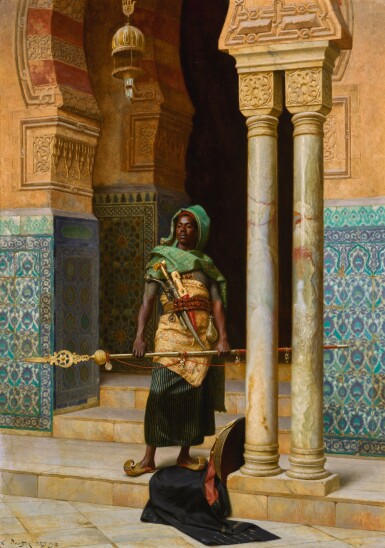Important Works from the Najd Collection
Important Works from the Najd Collection

LUDWIG DEUTSCH | THE NUBIAN GUARD
Auction Closed
October 22, 05:34 PM GMT
Estimate
800,000 - 1,200,000 GBP
Lot Details
Description
LUDWIG DEUTSCH
Austrian
1855-1935
THE NUBIAN GUARD
signed and dated L. Deutsch PARIS 1902 lower left
oil on panel
65 by 46.5cm., 25½ by 18in.
We are grateful to Dr Emily M. Weeks for her assistance in cataloguing this work which will be included in her critical catalogue of the artist's Egyptian and Orientalist works, currently in progress.
M. Newman Ltd., London ((by December 1960; as The Sheikh’s Bodyguard)
Coral Petroleum, Inc., Texas (sale: Sotheby's, New York, 22 May 1985, lot 23)
Mathaf Gallery, London
Purchased from the above
Caroline Juler, Najd Collection of Orientalist Paintings, London, 1991, p. 60, catalogued & illustrated
Images of standing guards, Deutsch's signature subject, arguably form the foundation of his legacy. These superlative portrayals offer a pristine palette and incredible attention to detail. Every vein in the Nubian guard's arm, every link in his chain mail, is observed minutely. To achieve this degree of verisimilitude, Deutsch relied not only on a magnifying glass but also, like Gérôme, on photographs. In fact, he had amassed a notable collection by the 1890s that aided his artistic process.
Yet Deutsch's portraits go beyond the photographic. Unlike a photograph which manifests in a fraction of a second, a painting like this, offering the illusion of a photographic snap-shot, took weeks or perhaps months to complete. While crafting the work, the artist expresses his sitter's personality, mien, and anatomy, as well as the setting with greater depth. The result, which photography cannot emulate, is an enhanced reality that allows a narrative tension to unfold through the layers of thought and observation that underpin it.
The viewer is struck, for example, by the Nubian's ambiguous stance: his stoic posture and eyes lowered in contemplation belie a gentler side to his personality. His station demands unfettered masculinity, yet he appears authentically human. And who or what is he guarding? The dark recesses of the gate reveal little. Perhaps we will never know, just as Deutsch, on his travels to Egypt, conceded that the regions he frequented held secrets that foreign visitors never discovered.
These layers of complexity, superimposed upon Deutsch's exceptional draughtsmanship and palette, made this subject so compelling to audiences in the nineteenth century, and continue to beguile collectors today.
